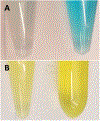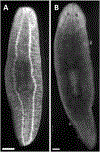Acetylcholinesterase Activity Staining in Freshwater Planarians
- PMID: 36799654
- PMCID: PMC9942112
- DOI: 10.1002/cpz1.674
Acetylcholinesterase Activity Staining in Freshwater Planarians
Abstract
The serine hydrolase acetylcholinesterase (AChE) is an important neuronal enzyme which catalyzes the hydrolysis of the neurotransmitter acetylcholine and other choline esters. The breakdown of acetylcholine by AChE terminates synaptic transmission and regulates neuromuscular communication. AChE inhibition is a common mode of action of various insecticides, such as carbamates and organophosphorus pesticides. Freshwater planarians, especially the species Dugesia japonica, have been shown to possess AChE activity and to be a suitable alternative model for studying the effects of pesticides in vivo. AChE activity can be quantified in homogenates using the Ellman assay. However, this biochemical assay requires specialized equipment and large numbers of planarians. Here, we present a protocol for visualizing AChE activity in individual planarians. Activity staining can be completed in several hours and can be executed using standard laboratory equipment (a fume hood, nutator, and light microscope with imaging capability). We describe the steps for preparing the reagents, and the staining and imaging of the planarians. Planarians are treated with 10% acetic acid and fixed with 4% paraformaldehyde and then incubated in a staining solution containing the substrate acetylthiocholine. After incubation in the staining solution for 3.5 hr on a nutator at 4°C, or stationary on ice, planarians are washed and mounted for imaging. Using exposure to an organophosphorus pesticide as an example, we show how AChE inhibition leads to a loss of staining. Thus, this simple method can be used to qualitatively evaluate AChE inhibition due to chemical exposure or RNA interference, providing a new tool for mechanistic studies of effects on the cholinergic system. © 2023 Wiley Periodicals LLC. Basic Protocol 1: Preparing the staining solution Basic Protocol 2: Fixing, staining, and imaging whole-mount planarian specimens for visualization of acetylcholinesterase activity.
Keywords: AChE inhibition; acetylthiocholine; butyrylcholinesterase; enzyme activity staining; flatworms.
© 2023 Wiley Periodicals LLC.
Conflict of interest statement
CONFLICT OF INTEREST STATEMENT:
EMC is the founder of Inveritek, LLC, which offers planarian screening commercially.
Figures






References
-
- Bullock TH, and Nachmansohn D 1942. Choline esterase in primitive nervous systems. Journal of Cellular and Comparative Physiology 20:239–242.
-
- Burke RD, Todd SW, Lumsden E, Mullins RJ, Mamczarz J, Fawcett WP, Gullapalli RP, Randall WR, Pereira EFR, and Albuquerque EX 2017. Developmental neurotoxicity of the organophosphorus insecticide chlorpyrifos: from clinical findings to preclinical models and potential mechanisms. Journal of Neurochemistry 142:162–177. Available at: http://www.ncbi.nlm.nih.gov/pubmed/28791702 [Accessed August 31, 2017]. - PMC - PubMed
-
- Cebrià F, and Newmark PA 2005. Planarian homologs of netrin and netrin receptor are required for proper regeneration of the central nervous system and the maintenance of nervous system architecture. Development (Cambridge, England) 132:3691–703. Available at: http://dev.biologists.org/content/132/16/3691.short [Accessed May 2, 2014]. - PubMed
-
- Ellman GL, Courtney KD, Andres V, and Featherstone RM 1961. A new and rapid colorimetric determination of acetylcholinesterase activity. Biochemical Pharmacology 7:88–95. Available at: http://www.sciencedirect.com/science/article/pii/0006295261901459 [Accessed October 16, 2015]. - PubMed
MeSH terms
Substances
Grants and funding
LinkOut - more resources
Full Text Sources
Medical

